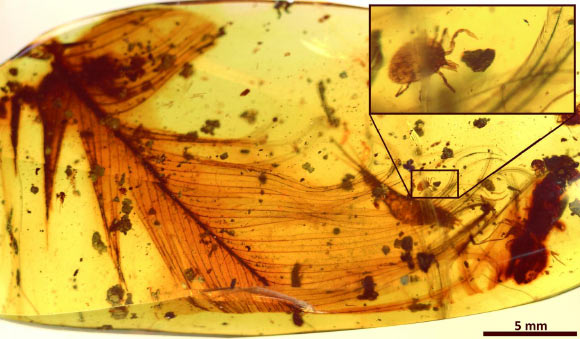Preserved in 99 million-year-old Burmese amber paleontologists found a tick grasping a dinosaur feather. The discovery, reported in the journal Nature Communications, is remarkable because fossils of blood-feeding parasites directly associated with remains of their host are exceedingly scarce, and the new specimen is the oldest known to date.

Hard tick grasping a dinosaur feather preserved in 99 million-year-old Burmese amber. Image credit: Peñalver et al.
“Ticks are infamous blood-sucking, parasitic organisms, having a tremendous impact on the health of humans, livestock, pets, and even wildlife, but until now clear evidence of their role in deep time has been lacking,” said lead author Dr. Enrique Peñalver, of the Spanish Geological Survey (IGME).
“The dinosaur feather with the grasping tick offers the first direct evidence of an early parasite-host relationship between ticks and feathered dinosaurs.”
“The fossil record tells us that feathers like the one we have studied were already present on a wide range of theropod dinosaurs, a group which included ground-running forms without flying ability, as well as bird-like dinosaurs capable of powered flight,” said co-author Dr. Ricardo Pérez-de la Fuente, from the Oxford University Museum of Natural History.
“So although we can’t be sure what kind of dinosaur the tick was feeding on, the mid-Cretaceous age of the Burmese amber confirms that the feather certainly did not belong to a modern bird, as these appeared much later in theropod evolution according to current fossil and molecular evidence.”

Reconstruction of the habitus of Deinocroton draculi on an immature feathered dinosaur. The reconstruction shows two unengorged males (left) and a female feeding to engorgement (right). Male body length 3.9 mm. Image credit: Peñalver et al / Oscar Sanisidro.
The paleontologists found indirect evidence of ticks parasitizing dinosaurs in Deinocroton draculi (Dracula’s terrible tick), belonging to a newly-described extinct group of ticks.
This species was found sealed inside Burmese amber, with one specimen remarkably engorged with blood, increasing its volume approximately 8 times over non-engorged forms.
Despite this, it has not been possible to directly determine its host animal.
But indirect evidence of the likely host for these novel ticks was found in the form of hair-like structures (setae) from the larvae of skin beetles (dermestids), found attached to two Deinocroton draculi ticks preserved together. Today, skin beetles feed in nests, consuming feathers, skin and hair from the nest’s occupants.
And as no mammal hairs have yet been found in Cretaceous amber, the presence of skin beetle setae on the two specimens of Deinocroton draculi suggests that the ticks’ host was a feathered dinosaur.
“The simultaneous entrapment of two external parasites is extraordinary, and can be best explained if they had a nest-inhabiting ecology as some modern ticks do, living in the host’s nest or in their own nest nearby,” said co-author Dr. David Grimaldi, from the American Museum of Natural History.
_____
Enrique Peñalver et al. 2017. Ticks parasitised feathered dinosaurs as revealed by Cretaceous amber assemblages. Nature Communications 8, article number: 1924; doi: 10.1038/s41467-017-01550-z







